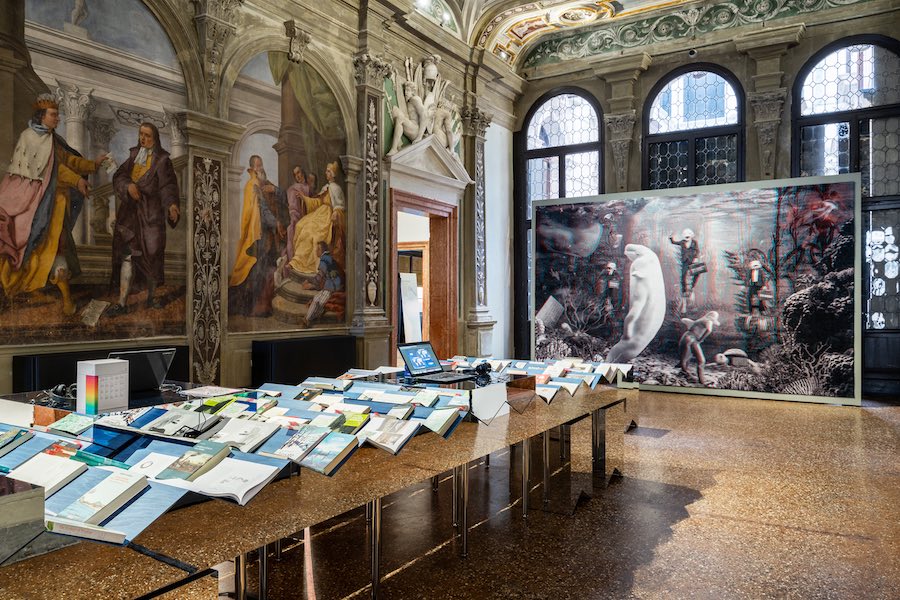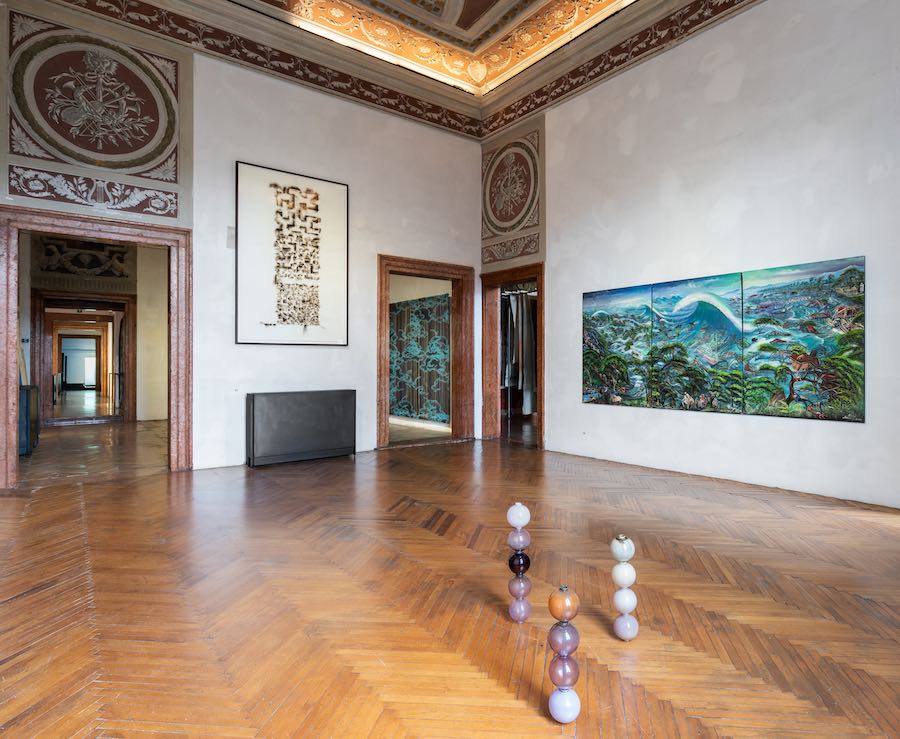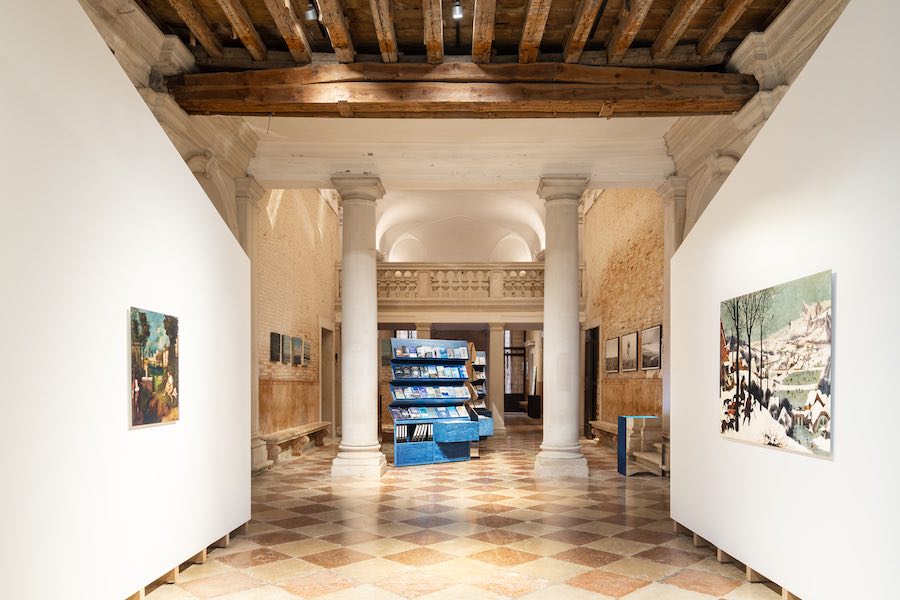
ENGLISH TEXT BELOW –
Qualsiasi dispositivo elettronico abbia accesso alla nostra posizione in tempo reale, ci comunica costantemente tre informazioni di base: l’orario, la data e la situazione meteorologica di quel momento e delle ore successive. “Che tempo fa lì?” è una delle domande che possiamo trovarci a ripetere più spesso nell’arco di una giornata, sia che ci si intrattenga al telefono con persone care lontane, sia che ci si trovi a dover far fronte a tempi morti imprevisti durante una call di lavoro. Parlare del tempo è una consuetudine che pone tutti gli interlocutori sullo stesso piano, quello di abitanti di questo pianeta. Si crea, perciò, una sorta di legame empatico nel riconoscimento della condizione in cui l’altro esiste, soprattutto quando il riferimento è a condizioni straordinarie: da “l’estate più calda degli ultimi decenni” a “l’inverno con le temperature più basse degli ultimi anni” e tutte le possibilità, anche drammatiche, che si frappongono tra gli estremi di questa linea meteorologica.
L’impatto pratico e psicologico che gli eventi atmosferici hanno sulla nostra vita è sempre maggiore: in un articolo pubblicato qualche giorno fa nella rubrica Annals of a Warming Planet del New Yorker, intitolato “What to do with climate emotions”, scritto dalla giornalista Jia Tolentino, si affronta il tema del “climate – therapy field”, ossia del cambiamento climatico come causa di stress e di disagio psicologico. “Climate Change Enters the Therapy Room” titolava un articolo online anche il New York Times poco più di un anno fa. Tolentino evidenzia la nostra incapacità di mettere a fuoco il problema con razionalità. Bombardati da annunci apocalittici da un lato e dall’altro intorpiditi nella reazione a eventi meteorologici gravi, siamo occidentali bisognosi di un supporto psicologico, che riceviamo nello studio climatizzato di un terapista, mentre gli effetti peggiori dell’emergenza climatica si stanno riversando su paesi i cui abitanti non hanno il tempo di riflettere su questo tema, perché sono costretti a vivere in “survival mode” da decenni. Ma il panico, se può essere la prima risposta a un allarme in corso, non è di certo quella definitiva.
L’arte può aiutarci ad attraversare la conversazione sul cambiamento climatico, e la mostra Everybody Talks About the Weather alla Fondazione Prada di Venezia (fino al 26 novembre 2023), curata da Dieter Roelstraete, può essere un punto di partenza per “evidenziare l’urgenza del cambiamento climatico, stabilendo un’equazione empirica tra meteorologia e climatologia, utilizzando insieme gli strumenti dell’arte e della scienza”, come scrive Miuccia Prada.

Il titolo della mostra fa riferimento al manifesto della Lega degli studenti socialisti tedeschi (Sozialisticher Deutscher Studentenbund) che nel 1968 lanciò lo slogan “Tutti parlano del tempo. Noi no.” giustapposto al triunvirato Marx – Engels – Lenin: parlare del tempo era la chiacchiera degli altri partiti politici su temi irrilevanti, mentre il partito socialista si occupava di questioni veramente importanti per la popolazione. Da qui, nel 2019 l’artista tedesca Anne-Christine Klarmann ha riproposto una parodia di quel manifesto con i volti di Judith Ellens, Carola Rackete e Greta Thumberg trasformando lo slogan in “Tutti parlano del tempo. Anche noi.”.
Tutti ne parliamo, o dovremmo parlarne. Nel mondo dell’arte, l’apertura a questo aspetto della contemporaneità e del passato recente non è ancora del tutto avvenuta. E la mostra sui due piani di Ca’ Corner della Regina cerca di tracciare una proposta di “lettura meteorologica dell’arte come un modo storicamente affidabile e concettualmente ricco” di affrontare questo impensabile iperoggetto che è il cambiamento climatico.
Ricerca scientifica e ricerca artistica corrono parallelamente nell’allestimento, svelando narrazioni spesso involontarie e connessioni nascoste tra opere d’arte e meteorologia. Al piano terra, l’installazione di Pieter Vermeersch incorpora otto riproduzioni di opere di epoca moderna che permettono di aprire numerosi discorsi sul rapporto tra clima e l’influsso del cambiamento climatico nella storia dell’arte.
Così, ad esempio, i colori del Mare di Ghiaccio di Friedrich (1823-24) hanno sì una connotazione estetica e simbolica, ma richiamano anche un evento geologico del 1915, ossia l’eruzione del Monte Tambora nelle Indie Orientali olandesi che determinò un drammatico raffreddamento mondiale, per cui il 1916 è ricordato come l’anno senza estate. I suoi effetti influirono su molte spedizioni polari, come quella di William Edward Parry a cui il pittore tedesco probabilmente si ispirò. Anche in Cacciatori nella Neve (1565), Bruegel dipinge una scena di caccia innevata, mentre si verificava il più drastico calo delle temperature avvenuto durante la “Piccola era glaciale” che causò ondate di carestie e inverni particolarmente rigidi tra la metà del Cinquecento e del Seicento.
Salendo al piano nobile del palazzo, nella splendida sala barocca decorata con stucchi e affreschi, opere di artisti contemporanei ci riportano al presente. Gran parte del salone accoglie l’installazione con le tele en plain air di Vivian Suter, sfiorate delicatamente dal flusso d’aria originato dall’opera dello scultore Nick Raffel, Fan: un ventilatore a basso consumo installato sul soffitto dello spazio, che richiama al contempo le cause e le conseguenze del cambiamento climatico. Sulla parete opposta, un enorme arazzo di Goshka Macuga ritrae in 3D la scena ambientata in un mondo marino distopico, di un corteo di creature più o meno riconoscibili in sciopero per la crisi climatica.


Nelle sale adiacenti, sono proposti moltissimi lavori che proseguono il discorso: Theaster Gates presenta il suo ultimo video, The Flood (2023), in cui la metafora dell’acqua nelle sacre scritture arriva dalla musica black, con cui l’artista è cresciuto frequentando la chiesa nel West Side Chicago, inframezzata dai discorsi di alcuni climatologi che parlano dei fenomeni atmosferici con razionalità e competenza; Beate Geissler & Oliver Sann hanno realizzato una partitura fatta di frammenti da testi del genere climate fiction, unico filone letterario che abbia trattato a fondo il tema del cambiamento climatico finora.
La tela Tsunami (2005) di Richard Onyango, i Rain Studies (2018) di Jitish Kallat, il dramma della morte delle api e i tessuti del colore della notte di Jason Dodge, i carotaggi di Giorgio Andreotta Calò, i cieli annuvolati di Chantal Peñalosa, Iñico Mangiano-Ovalle, Gerhard Richter e Vije Celmins: ogni opera si inserisce nel racconto di un fenomeno climatico. Infine, il video riflesso in uno specchio d’acqua dell’artista indiana Himali Singh Soin, intitolato We Are Opposite Like That (2019) prende le mosse da materiali d’archivio e poesie, che raccontano la storia di una incessante ansia per l’avvento di un’era glaciale in epoca vittoriana, con dei chiari riferimenti all’incertezza del presente.
Oltre alle opere, nello spazio espositivo è presente una serie di “stazioni di ricerca” che riuniscono più di cinquecento libri, pubblicazioni scientifiche, articoli, e video, con interviste a studiosi e attivisti. Tutti questi materiali permettono ai visitatori di approfondire le questioni scientifiche e culturali affrontate dalla mostra. Everybody Talks About the Weather, come le mostre Human Brains: It Begins with an Idea (2022) e Cere Anatomiche: La Specola di Firenze | David Cronenberg (2023), è un progetto della Fondazione Prada che prova ad affrontare le sfide culturali del nostro tempo, attraverso gli strumenti dell’arte e della scienza.
Everybody Talks About the Weather offre una nuova prospettiva sul rapporto tra noi e il tempo e tra il tempo e la crisi climatica. Se “l’immensità di questa crisi è soverchiante per le povere forze dell’immaginazione umana e, francamente, troppo deprimente per il nostro ansioso mondo dell’arte” – come scrive Roelstraete nel testo di mostra – la proposta di una visione meteorologica dell’arte, suggerisce “di continuare a parlare del tempo come modo di pensare l’impensabile, di dare un senso alla realtà corporea della nostra esposizione quotidiana – con la pioggia o con il sole – al mondo fisico, che è la nostra unica casa.”.

You don’t need a weather man, or a climate aware therapist. You just need to talk about the weather. EVERYBODY TALKS ABOUT THE WEATHER, FONDAZIONE PRADA VENEZIA
Any electronic device that has access to our real-time location constantly provides us with three basic pieces of information: the time, the date, and the current weather situation and forecast for the next few hours. “What’s the weather like there?” is one of the questions we may find ourselves repeating most often throughout the day, whether we are chatting with distant loved ones on the phone or dealing with unexpected downtime during a work call. Talking about the weather is a habit that puts all speakers on the same level, that of inhabitants of this planet. Consequently, a sort of empathic bond is created in recognizing the condition in which the other exists, especially when referring to extraordinary conditions: from “the hottest summer in decades” to “the winter with the lowest temperatures in years,” and all the possibilities, even dramatic ones, that lie between the extremes of this weather spectrum.
The practical and psychological impact that weather events have on our lives is increasing: in an article published a few days ago in the New Yorker’s Annals of a Warming Planet column, titled “What to do with climate emotions,” written by journalist Jia Tolentino, the topic of the “climate – therapy field,” or climate change as a cause of stress and psychological distress, is discussed. “Climate Change Enters the Therapy Room” also titled an online article in the New York Times just over a year ago. Tolentino highlights our inability to focus on the problem rationally. Bombarded by apocalyptic announcements on the one hand and numbed in our reaction to severe weather events on the other, we are Westerners in need of psychological support, which we receive in a therapist’s air-conditioned office, while the worst effects of the climate emergency are spilling over to countries whose inhabitants have no time to think about it because they have been forced to live in “survival mode” for decades. But panic, while it may be the first response to an ongoing alarm, is certainly not the final one.
Art can help us navigate the conversation about climate change, and the exhibition Everybody Talks About the Weather at the Fondazione Prada in Venice (through Nov. 26, 2023), curated by Dieter Roelstraete, can be a starting point to “highlight the urgency of climate change by establishing an empirical equation between meteorology and climatology, using the tools of art and science together,” as Miuccia Prada writes.
The title of the exhibition refers to the manifesto of the German Socialist Student League (Sozialisticher Deutscher Studentenbund), which in 1968 launched the slogan “Everyone talks about the weather. We don’t.” juxtaposed with the Marx – Engels – Lenin triunvirate: talking about the weather was the chatter of the other political parties on irrelevant issues, while the Socialist Party dealt with issues that really mattered to the people. Hence, in 2019 German artist Anne-Christine Klarmann repurposed a parody of that manifesto with the faces of Judith Ellens, Carola Rackete, and Greta Thumberg, transforming the slogan into “Everyone talks about the weather. So do we.”
We all talk about it, or should talk about it. In the art world, openness to this aspect of the contemporary and recent past has not yet fully occurred. And the exhibition on the two floors of Ca’ Corner della Regina attempts to trace a proposed “meteorological reading of art as a historically reliable and conceptually rich way” of addressing this unthinkable hyperobject that is climate change.

Scientific and artistic research run parallel in the installation, revealing often unintended narratives and hidden connections between works of art and meteorology. On the ground floor, Pieter Vermeersch’s installation incorporates eight reproductions of works from the modern period that open up numerous threads about the relationship between climate and the influence of climate change in art history.
Thus, for example, the colors of Friedrich’s Sea of Ice (1823-24) have, yes, an aesthetic and symbolic connotation, but they also recall a geological event of 1915, namely the eruption of Mount Tambora in the Dutch East Indies that resulted in a dramatic worldwide cooling, for which 1916 is remembered as the year without summer. Its effects affected many polar expeditions, such as that of William Edward Parry, from which the German painter was probably inspired. Even in Hunters in the Snow (1565), Bruegel paints a snowy hunting scene, as the most drastic drop in temperatures that occurred during the “Little Ice Age” that caused waves of famine and particularly harsh winters between the mid-sixteenth and seventeenth centuries occurred.
Ascending to the main floor of the palace, in the splendid Baroque hall decorated with stucco and frescoes, works by contemporary artists bring us back to the present. A large part of the hall accommodates an installation featuring Vivian Suter’s en plain air canvases, gently brushed by the flow of air originated by sculptor Nick Raffel’s work, Fan: a low-power fan installed on the ceiling of the space, which simultaneously recalls the causes and consequences of climate change. On the opposite wall, a huge tapestry by Goshka Macuga depicts in 3D a scene set in a dystopian sea world of a procession of more or less recognizable creatures on strike over the climate crisis.
In the adjacent rooms, a wide array of works that continue the discourse are being presented: Theaster Gates showcases his latest video, The Flood (2023), where the metaphor of water in sacred scriptures is intertwined with Black music, a vital part of the artist’s upbringing while attending church in Chicago’s West Side. The video is interspersed with speeches from climate scientists who approach atmospheric phenomena with rationality and expertise. Beate Geissler & Oliver Sann have created a score composed of fragments from climate fiction texts, the only literary genre that has extensively addressed the topic of climate change so far.
Richard Onyango’s Tsunami canvas (2005), Jitish Kallat’s Rain Studies (2018), Jason Dodge’s bee death drama and textiles of the color of night, Giorgio Andreotta Calò’s cores, and Chantal Peñalosa, Iñico Mangiano-Ovalle, Gerhard Richter, and Vije Celmins’ clouded skies – each work fits into the narrative of a climate phenomenon. Finally, Indian artist Himali Singh Soin’s video reflected in a body of water, titled We Are Opposite Like That (2019) draws on archival materials and poems, which tell the story of unrelenting anxiety about the coming of an ice age in the Victorian era, with clear references to the uncertainty of the present.
In addition to the artworks, the exhibition space features a series of “research stations” that bring together more than five hundred books, scientific publications, articles, and videos, with interviews with scholars and activists. All these materials allow visitors to delve deeper into the scientific and cultural issues addressed by the exhibition. Everybody Talks About the Weather, like the exhibitions Human Brains: It Begins with an Idea (2022) and Anatomical Waxes: The Florence Specola | David Cronenberg (2023), is a Fondazione Prada project that attempts to address the cultural challenges of our time through the tools of art and science.
Everybody Talks About the Weather offers a new perspective on the relationship between us and the weather, and between the weather and the climate crisis. If “the immensity of this crisis is overwhelming to the poor forces of the human imagination and, frankly, too depressing for our anxious art world” – as Roelstraete writes in the exhibition text – the proposal for a meteorological view of art, suggests “continuing to talk about the weather as a way of thinking about the unthinkable, of making sense of the bodily reality of our daily exposure-whether by rain or sun-to the physical world, which is our only home.”











